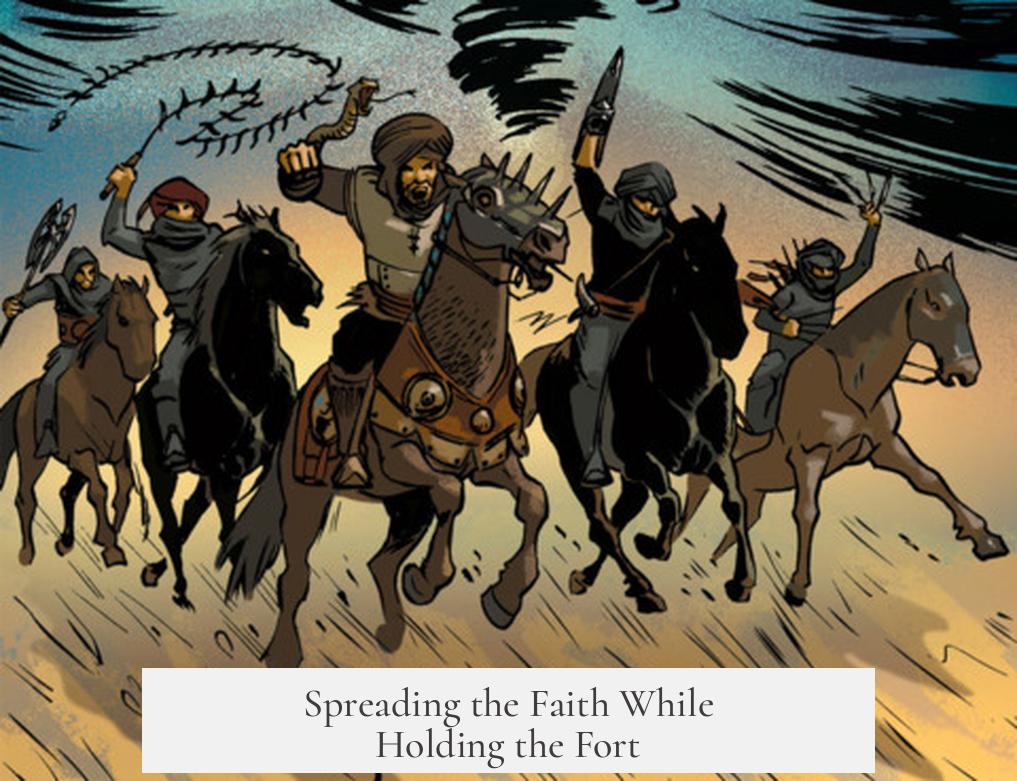The purpose of the real Order of Assassins (Hashashins) was to secure the survival and propagation of the Nizari Ismaili sect within Islam by defending the rightful leadership of their Imams, opposing rival caliphates, and establishing a strong political and military presence in a hostile environment.
The Order consisted exclusively of Nizari Ismaili Muslims who sought to elevate the Nizari line of Imams as the true successors and spiritual leaders of all Ismailis and former Fatimid Caliphs. After the dissolution of the Fatimid Caliphate, the Hashashins committed themselves to preserving their religious identity and ensuring their sect’s survival into the modern era.
Understanding the role of the Imam in Ismaili Shi’ism clarifies their primary motivation. The Ismailis viewed Ali, the cousin and son-in-law of Muhammad, as the rightful successor after Muhammad’s death. They believed that the Imam was infallible and that only one legitimate Imam existed at any given time. Observing the Imam’s authority and following his designated successor among Hussein ibn Ali’s descendants was a doctrinal necessity.
The Order’s foundation arose from a succession conflict following the death of Caliph Imam al-Mustansir. Two claimants vied for the Ismaili Imamate and Fatimid Caliphate: Nizar, the expected heir, and his younger brother Ahmed. Ahmed succeeded politically and assumed the title al-Mustali, while Nizar was executed. Loyalists of Nizar saw a religious and political duty to restore his progeny to power, leading to the formation of the Nizari faction and, ultimately, the Order of Assassins.
Hasan ibn Sabbah, the Order’s founder, established a fortified Nizari Ismaili state strategically positioned to resist overwhelming external powers. Surrounded by larger empires like the Seljuk Turks, who were seen as foreign invaders, the Nizaris adopted a robust defense strategy focusing on their impregnable mountain strongholds. The Order’s political and military tactic revolved around intimidating rivals and disrupting their authority with targeted assassinations.
The term “assassins” emerged because the Nizaris were willing to eliminate enemies who could not be intimidated through terror. This approach allowed the Order to survive and expand despite vastly inferior numbers and resources. Their actions instilled fear among dominant regional powers and preserved Nizari autonomy in volatile political landscapes.
Alongside military resistance, the Order promoted cautious, opportunistic expansion through missionary work. They sent da’is (missionaries) across Persia and Syria to convert local populations, extending the reach of Nizari Ismailism. Thus, the Hashashins pursued the dual goal of survival and propagation of their particular Islamic branch.
Religiously, the Order challenged competing Islamic authorities such as the Abbasid Caliphs. The Nizari Ismailis emphasized the doctrine of Talim, which underscored the spiritual authority and rights of their Imam. This doctrine questioned the legitimacy of other caliphates’ political and religious claims, particularly those of the Abbasids, intensifying sectarian tensions within the Muslim world.
Symbolism within the Order reflected their religious obedience and identity. While they had no official “logo,” recurring motifs appeared in inscriptions, such as a bathhouse adorned with the phrase “obedience to him [the Imam] is a duty.” Other symbols included calligraphy featuring the names of Muhammad and Ali, the lion symbol associated with Ali, and, in more recent times, a green flag with a red diagonal stripe. These symbols reinforced their devotion to the Imam and distinguished their community.
| Aspect | Details |
|---|---|
| Religious Identity | Nizari Ismaili Muslims; promotion of Nizari Imams as true leaders. |
| Succession Conflict | Support for Nizar’s claim against al-Mustali after Fatimid Caliphate split. |
| Political Strategy | Formation of fortified state; use of assassination for survival and intimidation. |
| Religious Doctrine | Emphasis on Talim doctrine; opposition to Abbasid legitimacy. |
| Expansion | Missionary activity in Persia and Syria to spread Ismailism. |
| Symbolism | Motifs reflecting obedience to the Imam, Muhammad, Ali, and Nizari identity. |
- The Hashashins’ core purpose was to secure the Nizari Imams’ authority within Ismailism and defend their sect.
- They adapted militarily and politically to survive against stronger empires via fortified strongholds and strategic assassinations.
- Religious mission included spreading Ismailism and opposing rival Sunni caliphates, especially the Abbasids.
- Symbolic practices underscored loyalty to the Imam and reinforced community identity.
What Was the Purpose of the Real Order of Assassins (Hashashins)?

In a nutshell, the real Order of Assassins (Hashashins) existed to secure, restore, and protect the legitimate Nizari line of Imams within Ismaili Shi’ism while ensuring the survival and expansion of their specific religious sect through a mix of political, military, and religious strategies.
That’s the short answer. But peel back the layers, and you find a complex, fascinating story involving theology, power struggles, and survival. Forget the Hollywood spy stuff. The Hashashins were not just shadowy killers with mysterious poisons; they were part of a deeply rooted religious and political movement.
Religious Identity: More Than Just a Secret Society
The Hashashins belonged to the Nizari Ismaili branch of Islam—a sect that historically sought to prove that their line of Imams was the true continuation after the fall of the Fatimid Caliphate.
Imagine a family drama with cosmic stakes. When the Fatimid Caliphate dissolved, many factions claimed authority. The Nizaris held fast to the belief that their Imam bloodline was the only legitimate one, and their mission was clear: make sure their Imam’s rule survived into the future.
This wasn’t a casual claim, either. For Ismailis, the Imam is infallible and chosen divinely, the spiritual and political leader of the community. Obedience isn’t a polite suggestion—it’s a core doctrine.
The Drama of Succession: A Family Feud That Changed History
The entire order springs from a dramatic succession dispute. After Caliph Imam al-Mustansir died, two contenders emerged: his heir apparent Nizar and his younger brother Ahmed.
Politics took center stage—Ahmed maneuvered into power, adopting the title al-Mustali, while Nizar was executed. Yet, Nizar’s supporters, including the Hashashins, refused to accept this verdict.
Instead, they believed it was a religious duty to fight for the restoration of Nizar’s descendants as rightful Imams and, by extension, rightful rulers of the Fatimid Caliphate. This split formed the ideological backbone of the Hashashin cause.
Political Survival: Tough Fortresses and Tougher Tactics
So how did this small faction survive surrounded by more powerful empires? Enter Hasan-i Sabbah, the visionary leader who founded the Nizari Ismaili state.
Sabbah didn’t just wait for enemies to trip over him. Instead, he built nearly impregnable mountain fortresses. These strongholds were both military bases and symbolic seats of power.
Now, imagine you are constantly sandwiched between imposing neighbors like the Seljuk Turks. What do you do? The Hashashins leaned on psychological warfare.
They gained a reputation for bold assassinations of political and military leaders—a tactic designed more to inspire fear and respect than to indiscriminately kill. If intimidation failed, they resorted to targeted elimination.
This was a survival strategy as much as a political one. The order showed that a small, well-organized group could punch above its weight in the medieval power game.
Spreading the Faith While Holding the Fort

The Hashashins weren’t just about defense. They actively pushed for the expansion of their religious beliefs and influence.
Missionaries traveled throughout Persia and Syria, preaching Nizari Ismailism. This cautious, opportunistic outreach gradually cemented new communities under their influence.
It was both spiritual and strategic. Every new convert strengthened their political power, expanded their territory, and helped protect the Nizari Ismaili lineage.
Opposition to Rival Powers: Religious and Political Confrontation
The Nizari Ismaili state stood in theological opposition to dominant Sunni powers, especially the Abbasid Caliphs.
They emphasized the doctrine of Talim, which underscored the rights and legitimacy of the Nizari Imam. This doctrine implicitly challenged the authority of the Abbasid rulers, who claimed caliphal legitimacy for themselves.
Their resistance wasn’t just about land or politics; it was rooted in a religious conviction that their leadership line was the true continuation of Islam’s rightful authority.
Symbols of Devotion: Visual Signs of Loyalty
The Hashashins didn’t have logos like your average corporation, but symbolism mattered.
Locations linked to the order were inscribed with reminders such as “obedience to him [the Imam] is a duty.” Lions represented Ali, the revered figure from whom the Imamate claims descend.
This symbology reinforced loyalty, constantly reminding members that their cause was about more than politics—it was a spiritual commitment.
Putting It All Together: What Can We Learn?
The order’s purpose breaks down into several key objectives:
- Restoration of the Nizari Imam Line: Defend and assert the rightful succession after a bitter dispute.
- Survival of the Sect: Build fortresses, form a state, use targeted assassinations to outmaneuver stronger foes.
- Propagation: Spread Ismaili beliefs to new regions through missionary work.
- Religious Opposition: Challenge Sunni dominance in theology and politics.
- Symbolic Obedience: Maintain allegiance to the Imam through doctrine and symbols.
This rejects the Hollywood myth that the Hashashins were just mysterious killers cloaked in shadow. Their purpose was religious, political, and pragmatic, grounded in an intense quest for legitimacy and survival.
Can History’s Assassins Teach Us Anything Today?

Absolutely. The Nizari Ismailis were masters of strategy, combining ideology with military tactics—not unlike some modern movements, without the Hollywood drama.
They balanced belief and survival, flooding hostile environments with doctrine, architecture, and precise political action.
They also remind us that religion isn’t just personal faith; it can powerfully shape politics and history.
A Final Thought: Beyond the Name
Next time someone says “Assassins,” think beyond the knife and smoke bombs. The real Hashashins represented a determined minority rallying for religious legitimacy and political survival, leaving a mark on history greater than their infamous reputation suggests.




